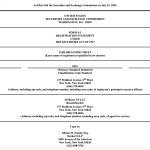The Bitcoin mining hashrate has been decreasing recently, coinciding with a downturn in the cryptocurrency’s price.
Decrease in 7-Day Average Bitcoin Mining Hashrate
The term “mining hashrate” represents the total computing power miners have connected to the Bitcoin blockchain, giving an insight into the network’s miner activity.

An increase in this metric indicates more miners joining or expanding, indicating a strong network. Conversely, a decrease suggests miners disconnecting due to profitability concerns.
Here is a chart showing the trend of the 7-day average Bitcoin mining hashrate in the past year:
The all-time high in the hashrate corresponded with a Bitcoin price surge, while the subsequent decline aligns with a bearish market sentiment. Miners’ revenue is closely tied to the asset’s price, affecting their decision to add or remove hashrate.
Miners earn from transaction fees and block rewards, with revenue heavily influenced by the cryptocurrency’s value. As Bitcoin faced fluctuations, miners’ hashrate adjustments mirrored the price movements.
Despite Bitcoin’s price surpassing $62,000 recently, the hashrate didn’t rise proportionally, hinting at miners’ cautious outlook. The upcoming network difficulty adjustment is expected to reflect the reduced hashrate.

Bitcoin’s difficulty level regulates mining speed to maintain a steady block time. With declining hashrate, the network will adjust the difficulty down by over 4% to support miners.
Current Bitcoin Price
Bitcoin is currently trading around $59,700, showing a 19% increase over the past week.


